Tang Dynasty (618-907AD) is considered the Golden Age of Chinese history; it was the most prosperous and splendid period. Lasting from 618 to 907AD with 22 Tang Emperors, the Tang Empire became the most powerful and prosperous country worldwide. The economy, politics, culture, and military strength reached an unparalleled advanced level in this glorious period.
In 581, Yang Jian (a general of Northern Zhou Dynasty) usurped the throne of the Northern Zhou and established the Sui Dynasty, ending the 400-year-long separating times in  China. The Sui Dynasty, established by Yang Jian, only lasted for 38 years and had two emperors. When Emperor Yang (Yang Jian’s son) of the Sui Dynasty ascended the throne, he was so extravagant, atrocious exploitative, and abusive that many uprisings broke out in the country. In 617, Li Yuan, a powerful Sui official, and his sons seized the opportunity to join the revolt and grew strong. In the next year, he led the army and forced the young son of Emperor Yang of the Sui Dynasty to abdicate. Therefore, the Tang Dynasty was established in 618, and the capital city was set in Chang’an (today’s Xi’an).
China. The Sui Dynasty, established by Yang Jian, only lasted for 38 years and had two emperors. When Emperor Yang (Yang Jian’s son) of the Sui Dynasty ascended the throne, he was so extravagant, atrocious exploitative, and abusive that many uprisings broke out in the country. In 617, Li Yuan, a powerful Sui official, and his sons seized the opportunity to join the revolt and grew strong. In the next year, he led the army and forced the young son of Emperor Yang of the Sui Dynasty to abdicate. Therefore, the Tang Dynasty was established in 618, and the capital city was set in Chang’an (today’s Xi’an).
The reign of Emperor Taizong, Wu Zetian, and the early part of Emperor Xuanzong are called the time of the "Benign Administration of the Zhenguan Reign Period" and the "Flourishing Kaiyuan Reign Period."
Emperor Taizong, Li Shimin, named the period of his reign Zhengguan (627-649). Drawing lessons from the downfall of the Sui Dynasty, Emperor Taizong carried out many enlightened policies and measures beneficial to the country and the people, creating “the Benign A administration of the Zhenguan Reign Period." After Li Shimin died, the throne passed to his ninth son Li Zhi who was later crowned as Emperor Gaozong and married Li Shimin's imperial concubine Wu Meiniang.
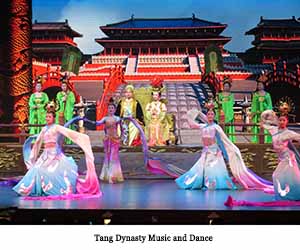 Emperor Gaozong loved Wu Meiniang very much and he, not being in good health, often let her handle his things for him. Therefore, Wu Meiniang soon became much involved in affairs of state. Later, Wu Meiniang was officially renamed Wu Zetian. At that time, Emperor Gaozong and Wu Zetian were called the “Two Saints” by the people, which meant they had two emperors. After Gaozong died in 690, Wu Zetian proclaimed herself as the emperor and changed the dynasty name to Zhou, which lasted for 15 years. She carried on developing production initiated by Emperor Taizong and promoted many talented people in defiance of the protocol. During her reign, the state economy continued to grow rapidly.
Emperor Gaozong loved Wu Meiniang very much and he, not being in good health, often let her handle his things for him. Therefore, Wu Meiniang soon became much involved in affairs of state. Later, Wu Meiniang was officially renamed Wu Zetian. At that time, Emperor Gaozong and Wu Zetian were called the “Two Saints” by the people, which meant they had two emperors. After Gaozong died in 690, Wu Zetian proclaimed herself as the emperor and changed the dynasty name to Zhou, which lasted for 15 years. She carried on developing production initiated by Emperor Taizong and promoted many talented people in defiance of the protocol. During her reign, the state economy continued to grow rapidly.
Kaiyuan (713-741) was the earlier reign title of Li Longji, Emperor Xuanzong (685-762). Through over 100 years of development from the beginning of the Zhenguan reign of Taizong to the end of Kaiyuan reign, the Tang Dynasty became unprecedentedly prosperous. Therefore, people refer to the time as the "Prosperous Kaiyuan Period." During the Kiayuan Period, society was stable and peaceful, and commerce and transportation were highly developed, and Chang'an City was the largest and the most prosperous metropolis in the world. The Tang dynasty reached its summit of prosperity during Xuanzong’s reign.
In the second half of his reign, during the Tianbao Period(742-756), Emperor Xuanzong was obsessed with his favorite concubine, Lady Yang. He neglected his duties, and the court became corrupt, and the army was weakened. An Lushan (703-757) wormed his way into Emperor Xuanzong's confidence and took command of a significant part of the armed forces. In 756, An Lushan and Shi Siming staged a revolt in Fanyang (current north of Hebei province) with 150,000 men, marching toward the capital city. This was known historically as the Revolt of An Lushan and Shi Siming. It was until the year 762 that the revolt was finally suppressed. This revolt caused severe damage to north China's economy and marked the decline of the Tang Dynasty.
From then on, the national strength was weakened daily by separatist forces in local areas. The emperors' incompetence, the dominance of the eunuchs, and the power struggles between chancellors became increasingly intense. Hence the Tang Dynasty declined from generation to generation. In 859, a large-scale peasant uprising relaunched by Huang Chao severely attacked the Tang regime. In 907, the last Tang emperor, Emperor Aidi, was forced to abdicate by Chancellor Zhu Quanzhong, who afterward changed the state title into Liang, finally putting the ever powerful and mighty dynasty to an end.
In the early Tang Dynasty, the national territory was divided into two organizational structures to Zhou (provinces) and Xian (counties). The head chief of these places was all assigned from the central government. In the later Tang Dynasty, a higher level called Dao was put in before Zhou; thus, three organizational structures were developed.
The central official system followed the Sui Dynasty's (581 - 618) Three Departments and Six Ministries system. Zhongshu Ministry, Menxia Ministry, and Shangshu Ministry were the country's leading administrative organizations, in charge of decision-making and drafting orders, and reviewing and executing state affairs. Under the Shangshu Ministry, six departments were set up. The Li (吏) Department was in charge of the appointment and assessment of officials. The Hu Department was in charge of land resources, household registry, taxation, and financial affairs. The Li (礼) Department was in charge of ritual affairs, celebrations, sacrifices, schools, and imperial examinations. The Bing Department was in charge of officer selections, serviceman registry, military orders, and weapons. The Xing Department was in charge of laws, orders, the judiciary, criminal punishment, and prisons. The Gong Department was in charge of civil engineering, irrigation and flood control, arable land, traffic, etc. The heads of these three ministries were prime ministers. Their jobs were to discuss state affairs with the emperor and assisted him in ruling the country. Meanwhile, the different departments can supplement each other and check and balance each other. Besides, nine 'Si's and five 'Jian's were set up to work with the six ministries.
Tang's laws simplified the system of the Sui and had lighter penalties. The execution was very prudently applied, and five times reviews were required before any implementation. Comment on the Law of the Tang Dynasty is the earliest extant code in China, having significant influences on Asian countries throughout history.
The official selection system with imperial examination broke the rich and powerful families' monopoly, expanded the social foundation for the central regime, and injected a new force into social development. It created a relatively objective, equitable, and fair official selection mechanism to ensure the continuous introduction of talented people and providing the state organization with a systematic guarantee for robust, stable, and efficient performance.
The prosperity of the early Tang came from contemporary economic and social development. The reclamation of land and irrigation marked with bending shaft plows and scoop waterwheels gave higher freedom to individual peasants, leading to the rapid growth of intensively cultivated small land blocks and producing many middle and small landlords. Meanwhile, the decadent gentry or landlords crushed by the widespread peasant wars at the end of the Sui Dynasty gradually died. The individual cultivation-based landlord broke the fetters of those gentry families. They started to get full play in state politics, initiating a range of far-reaching innovations in the prevailing systems.
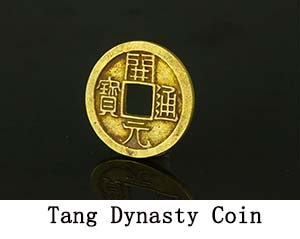
Emperor Taizong implemented many measures that enjoyed the people's support, such as joining counties and prefectures to reduce expenditure, letting peasants have a certain amount of land, and reducing the burden of corvee labor to ensure that peasants had time to work on their land.
During the Kaiyuan period, society was stable and peaceful, and commerce and transportation were highly developed. Yangzhou, located where the Grand Canal meets the Yangtze River, was a bustling city where merchants from all over China and abroad converged. Chang'an, the capital city, was then one of the world's great metropolises. Envoys, merchants, scholars, and artisans of many countries flocked to Chang'an to trade and study the Tang Dynasty's advanced culture and technology.
The Tang Dynasty was prosperous in the economy and liberal in politics. It promoted the rapid development of culture and education, setting up a complete school education system from the central to the local, involving laws, mathematics, and other majors. 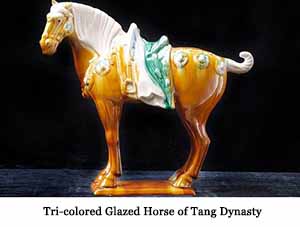
This period was the golden age of ancient Chinese poetry, with more than 5,000 poems passed down to the present generations. Prosperity, openness, and cultural diversity and the enterprising spirit encouraged by the fresh official selection system jointly created Tang poetry's brilliance. There were many famous poets in this period, such as Li Bai, Du Fu, Meng Haoran, Wang Wei, etc.
Paintings of the Tang Dynasty covered more and more fields, with figures, landscapes, flowers, and birds separated. There is a combination of calligraphic styles of both South and North, which featured gracefulness and vigorousness. Many famous calligraphers such as Ouyang Xun, Yan Zhenqing, and Liu Gongquan emerged.
Affected by alien cultures, the music and dance in the Tang dynasty were colorful in styles. Emperor Xuanzong, mastered in music rhythms, once granted a pear park for 300 musicians to practice dance and singing techniques, and personally created The Ancient Dance Music of Imperial Palace with Lady Yang by taking the styles of Western Regions for reference.
The Tang dynasty boasted developed outbound traffic. The land route ran from present-day India, Pakistan, Afghanistan, and Iran to the Persian Gulf. It further extended to many European and African countries through Central Asia and the Mediterranean Sea. The sea route started from today's South Korea and Japan in the east and ended in the Persian Gulf in the west. The Tang Dynasty's policies that encouraged openness and communication and the smooth land and sea routes gave rise to widespread Sino-foreign exchanges.
Japan had sent its emissaries to the Tang Dynasty 13 consecutive times, with Japanese students going with each emissary numbering into the hundreds. In 645, Japan launched Taika Reform, taking the Tang Dynasty as a model in many aspects, including political, legal, land, and tax systems, and even constructing the capital city. Ku Kai, a Japanese scholar-monk who once went to the Tang Dynasty to study Buddhism, adopted Chinese characters' components to create Japanese letters called Katakana. Jianzhen, a monk of the Tang Dynasty who crossed the ocean eastward to Japan, carried out monkhood initiation for the Japanese emperor, empress, prince, and ordinary people, which significantly influenced Japanese culture. 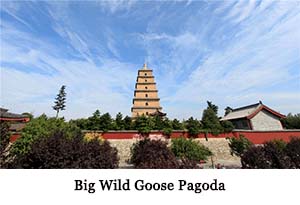
In the late seventh century, Silla on the Korean Peninsula also sent students to the Tang Dynasty and imitated such Tang systems as the six departments and official selection through imperial examinations.
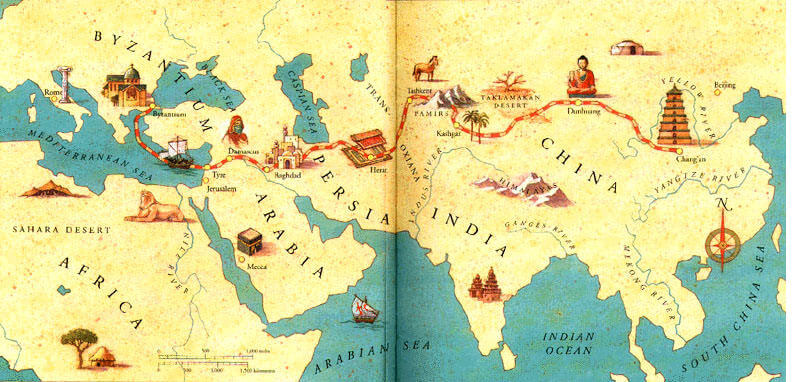
Tang Dynasty Silk Road
Watch the World Famous Tang Dynasty Show and See How Prosperous Tang Dynasty Used to Be
Meet the Only Empress in Chinese History Wu Zetian in Theater and Listen to Her Stories
Pay A Visit to the Joint Mausoluem of Gaozong Emperor and Wu Zetian
Try Some Tang Dynasty Clothings and Shoot Pictures
Copyright © 2019 Lily Sun China Tours International, Inc. Terms &conditions | Privacy Policy | Sitemap